Many people collect one type of object,
whether it be enameled pins from the Olympics, postage stamps,
glassware, tea cups, or travel souvenirs. Not so with Edith Kelly
Fetherston of Lewisburg, Pennsylvania. She had a passion for collecting
and not much got past her keen collecting eye. The result is a houseful
of collections—a testament to her passion.
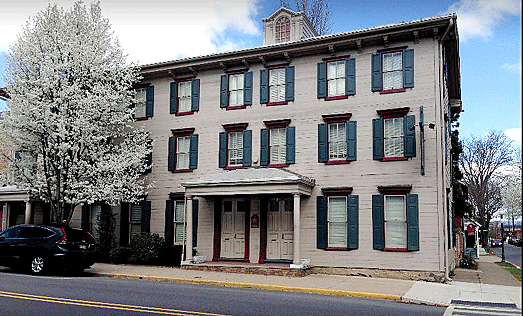
Standing on a corner of Market Street across from the Susquehanna River
Bridge is the Packwood House Museum. It stands out from the other
buildings on the street only because of its size. Other than that, it
looks like a charming townhouse. The building is one of the oldest and
most historic in town, its clapboard siding hiding its original log
cabin structure.
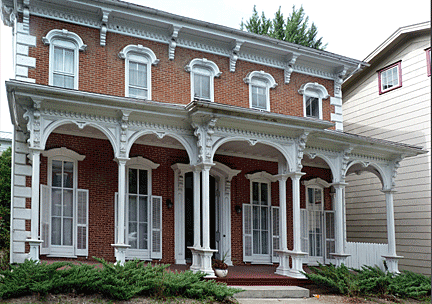 Originally
constructed as a two-story log cabin between 1796 and 1799, it served as
a tavern and in for travelers along the Susquehanna River. The Erie
Canal opened in 1855. It was the main canal up the Susquehanna River
while the West Branch of the Pennsylvania Canal flowed a mile west of
town. But with the completion of the crosscut canal connecting the two
at Lewisburg, the tavern grew into the American House Hotel. The hotel
eventually expanded into an impressive three-story 27-room structure.
Originally
constructed as a two-story log cabin between 1796 and 1799, it served as
a tavern and in for travelers along the Susquehanna River. The Erie
Canal opened in 1855. It was the main canal up the Susquehanna River
while the West Branch of the Pennsylvania Canal flowed a mile west of
town. But with the completion of the crosscut canal connecting the two
at Lewisburg, the tavern grew into the American House Hotel. The hotel
eventually expanded into an impressive three-story 27-room structure.
The Pennsylvania Railroad arrived in Lewisburg’s downtown in 1869,
followed by the Reading Railroad in 1883, signaling the end to river
travel and a decline in guests for the hotel. By the late 1880s, the
American House Hotel had to close for lack of business. It’s owners
converted it into three townhouses.
Edith Fetherston Begins Her Collection
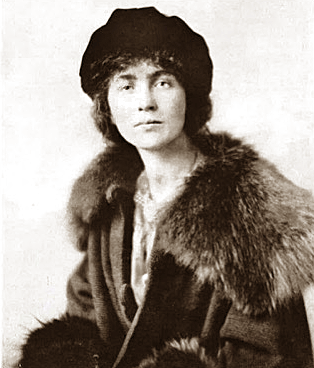 Edith
Fetherston inherited two of the townhouses. The third had been converted
into the Kelly House Apartments. She and her husband purchased the Kelly
House Apartments to make the 27-room structure into a place where they
could retire. She met John, a successful New York civil engineer, in
Atlantic City, New Jersey, while teaching in Baltimore in 1916, After
living in various locations along the East Coast, they decided to return
to Lewisburg where Edith was born. They named their new home “Packwood”
after a Fetherston family ancestral home in England.
Edith
Fetherston inherited two of the townhouses. The third had been converted
into the Kelly House Apartments. She and her husband purchased the Kelly
House Apartments to make the 27-room structure into a place where they
could retire. She met John, a successful New York civil engineer, in
Atlantic City, New Jersey, while teaching in Baltimore in 1916, After
living in various locations along the East Coast, they decided to return
to Lewisburg where Edith was born. They named their new home “Packwood”
after a Fetherston family ancestral home in England.
Besides holding a Bachelor of Philosophy and a Master’s degree in
education from Bucknell University, Edith, who was also an artist,
garden designer, and collector, acquired the majority of the works on
display in this small museum. She subsequently traveled to Europe to
perfect her skills in French and German, returning to the United States
to teach in various schools until her marriage to John in 1917. Later in
life she also traveled to Japan, Central Asia, and the Middle East.
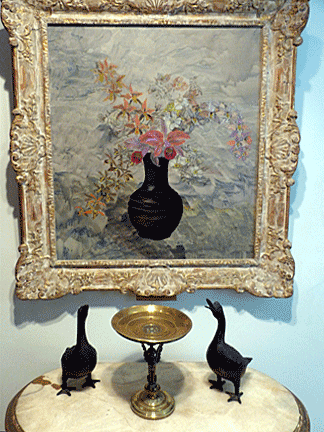 Today,
visitors can tour through room after room filled with antique glass,
ceramics, textiles, furniture, paintings, Pennsylvania German decorative
arts, and Oriental art. Edith’s 1930’s Oriental/Pennsylvania woodland
garden also boasts the area’s only collection of century-old cryptomeria
trees, also known as Japanese cedars.
Today,
visitors can tour through room after room filled with antique glass,
ceramics, textiles, furniture, paintings, Pennsylvania German decorative
arts, and Oriental art. Edith’s 1930’s Oriental/Pennsylvania woodland
garden also boasts the area’s only collection of century-old cryptomeria
trees, also known as Japanese cedars.
The Packwood House collection is result of Edith’s travels and her
eclectic and cosmopolitan taste. It includes antique furniture,
decorative objects, and works of art that added delight to the
Fetherstons’ daily life. Displayed throughout the house are Edith’s own
paintings, souvenirs from her travels, such as a bronze camel from
Mongolia and an icon from Jerusalem, early Pennsylvania furniture, tramp
art, Tiffany glass, Anatolian and Persian rugs, and numerous examples of
Japanese and Chinese decorative arts. The museum also retains Edith’s
wardrobe of designer clothes, shoes, and handmade hats. The arrangement
of the rooms remains faithful to the appearance of her home at the time
of her death.
Touring Packwood Museum
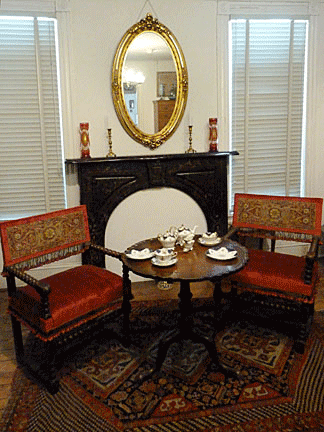 Tours
of the museum begin in the Garden Room, just off the garden. Wooden
chairs, signed Pennsylvania House, stand around a small table. The room
displays part of Edith’s collection of redware. Her discovery of a
redware plate in her garden inspired her to begin collecting it.
Tours
of the museum begin in the Garden Room, just off the garden. Wooden
chairs, signed Pennsylvania House, stand around a small table. The room
displays part of Edith’s collection of redware. Her discovery of a
redware plate in her garden inspired her to begin collecting it.
From the garden room it’s a short walk into the dining room, with its
decorative mirrors and large folding screen that Edith used to block
drafts.
Some of Edith’s paintings hang in her former reception room. Each has a
water stain motif. The room also contains her collection of Asian art,
including carved wooden elephants once owned by the King of Siam. A Han
vase from China stands in the adjacent main entrance hall.
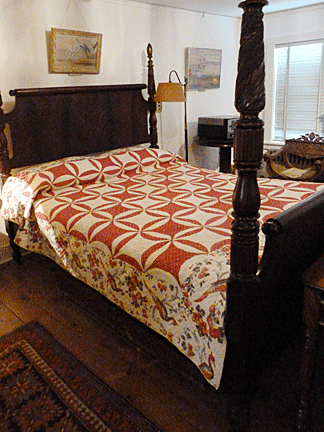 Climbing
the stairs to the second floor reveals the sleeping porch with windows
on three sides which Edith used as a summer bedroom. One of the 250
antique quilts in the collection, dating from the mid-19th to the
mid-20th century, lies on the bed.
Climbing
the stairs to the second floor reveals the sleeping porch with windows
on three sides which Edith used as a summer bedroom. One of the 250
antique quilts in the collection, dating from the mid-19th to the
mid-20th century, lies on the bed.
The reading room gallery features several revolving bookcases, as well
as a collection of wooden side chairs. Edith knew multiple languages.
Her study contains a desk owned by Bruce Klimpt, a local Revolutionary
War hero.
She kept a separate bedroom from her husband on the third floor. In it
stands a red dressing table she purchased from the owner of a hat shop
on Market Street. A drop-front secretary desk in the American Empire
Revival style stands along the outside wall. The quilt on the bed of
painted chintz dates from the 1840s.The back bedroom features a quilt
from 1813, a chips and wet stone design, the oldest in the collection.
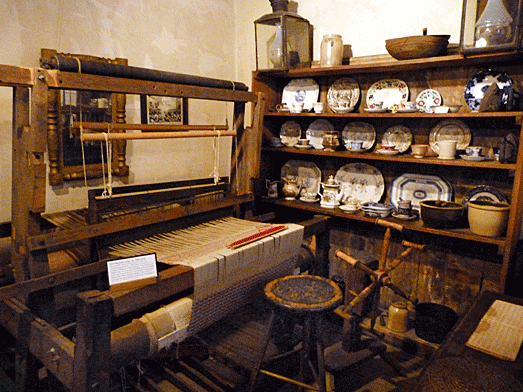
Another room on the second floor displays
weaving looms from the 1840s to the 1870s, most built for woolen mills.
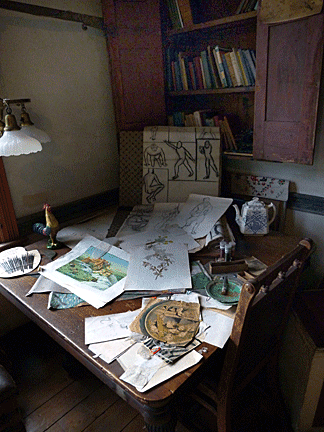 Edith
was a passionate artist. Her studio contains her sketches and palette,
as well as an undertaker’s closet on which she tested her rouge on the
door. Over in the corner stands her private dental chair. Because of her
bad hips, she couldn’t walk to the dentist, so she bought her own chair
and had her dentist come to her home to service her teeth.
Edith
was a passionate artist. Her studio contains her sketches and palette,
as well as an undertaker’s closet on which she tested her rouge on the
door. Over in the corner stands her private dental chair. Because of her
bad hips, she couldn’t walk to the dentist, so she bought her own chair
and had her dentist come to her home to service her teeth.
Her former sewing room now displays more quilts from the collection.
Edith called it her trunk room.
John’s office is off the main entrance on Market Street. Displayed in
the waiting room are four paintings of Edith’s rooster, which she called
Alfie. The first is the “Tomato Cockwain,” followed by “The Bridgeroom
Cometh,” “Repository—Little Hitler With Ruffled Feathers,” and finally
“The Cocktail Party.” All show Edith’s wry sense of humor.
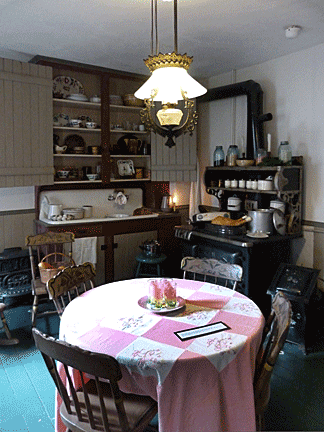 Edith’s
kitchen has been turned into a turn-of-the-century kitchen with a
stenciled floor and deluxe commercial ice box. A camelback tray, used by
desert nomads to eat on the ground, could be easily carried on the back
of a camel.
Edith’s
kitchen has been turned into a turn-of-the-century kitchen with a
stenciled floor and deluxe commercial ice box. A camelback tray, used by
desert nomads to eat on the ground, could be easily carried on the back
of a camel.
The American House Hotel’s original tavern room now houses a collection
of storage cabinets, including armoirs and kases, as well as stoneware
and redware pieces. Two of the carved wardrobes were made in Lewisburg.
There’s also a Pennsylvania Dutch bridal dowry chest, high German and
Swiss Alsacian painted furniture, portraits, crocks, an apple butter
churn, ladels, and milk-painted corner cupboards from the 1820s.
Among all the items in her collection, Edith’s high-fashion wardrobe
from the 1920s and 1930s stands out. Dresses and accessories appear in
glass-enclosed nooks through the house. One of the most unusual items is
a conical hat box used to store hats worn by workers in Chinese rice
patties.
More photos from
the Packwood House Museum
< Back to Collecting Archives
Next
Article >
